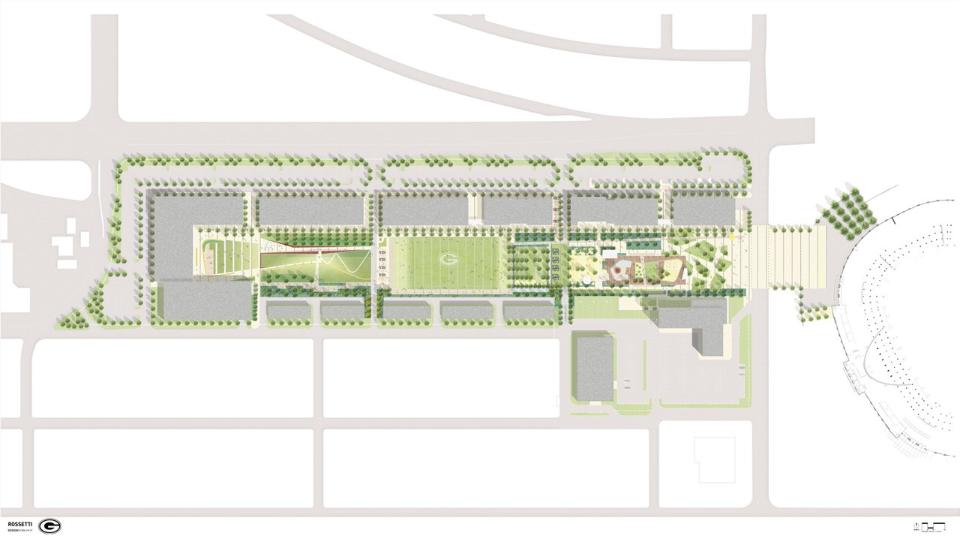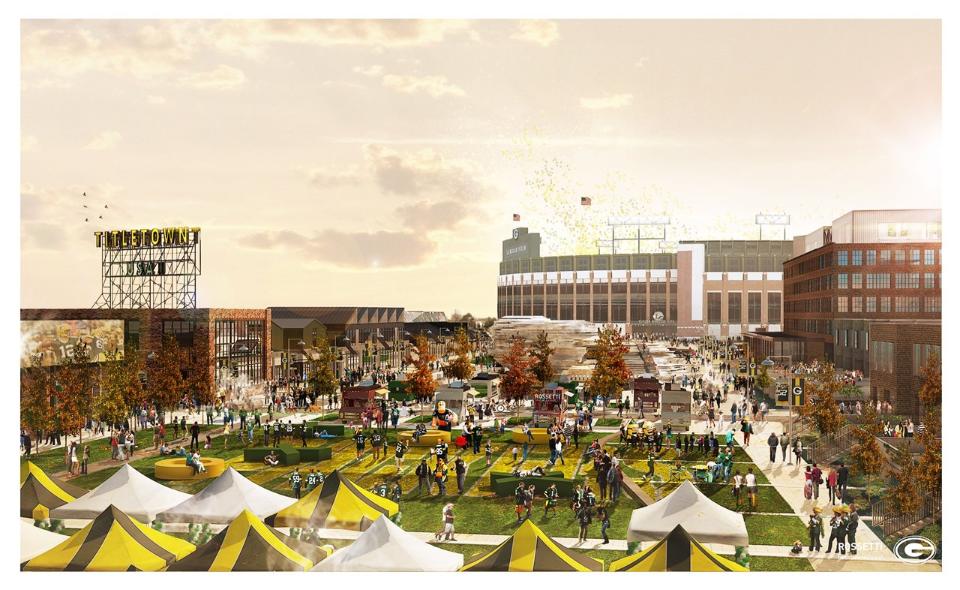This fall, the Green Bay Packers will break ground on Titletown District, a mixed-use development west of the NFL team's home of Lambeau Field. When completed in the fall of 2017, the first phase of Titletown District will include a hotel, a sports medicine center, a restaurant/brewery, and a 10-acre public plaza.
The Milwaukee Business Journal reports that the first phase of this project is expected to cost between $120 million and $130 million, with the Packers contributing $65 million of that total.
For several years, the Wisconsin-based team has been acquiring land in town and demolishing buildings in preparation for starting Titletown District. The first tenant, a 100,000-sf Cabela’s sporting goods outlet the retailer developed with the team, opened in July 2014 and drew 2.8 million visitors in its first 12 months in business.
The Journal reports that this fall the Packers and its Building Team—which includes Sterling Project Development, a New York real estate advisory firm; Rossetti, a Detroit architectural design and planning firm; and Biederman Redevelopment Ventures, a New York design consultant with expertise in public-spaces and streetscapes—will begin installing infrastructure on eight of the project’s 20 acres for initial tenants that will include a five-story, 150-room, four-diamond hotel to be call Lodge Kohler, which the bath and kitchen fixture supplier Kohler Co. will build and operate.
The hotel will not only provide rooms for fans attending Packers’ games, but should also benefit from the 700 events the team conducts annually.
Other initial tenants will include a 20,000-sf Hinterland restaurant/brewery; and a 30,000-sf sports medicine facility called Bellin Health, which will feature lab, X-ray, and MRI services. The Packers’ team physician Dr. Patrick McKenzie will staff the clinic.
The publicly owned Packers reported $375 million in revenue for fiscal year 2015, up 16%. Team president Mark Murphy said the franchise continues to acquire land with an eye toward further regional economic development that could include residential buildings.


Related Stories
| Mar 1, 2012
Bomel completes design-build parking complex at U.C. San Diego
The $24-million facility, which fits into a canyon setting on the university’s East Campus, includes 1,200 stalls in two adjoining garages and a soccer field on a top level.
| Feb 24, 2012
Skanska hires Tingle as senior VP and national director for its Sports Center of Excellence
Tingle has worked in the architecture and construction industries for more than 30 years, and for the last 23 years, he has focused primarily on large-scale sports construction projects
| Feb 2, 2012
Shawmut Design and Construction launches sports venues division
Expansion caps year of growth for Shawmut.
| Jan 31, 2012
Fusion Facilities: 8 reasons to consolidate multiple functions under one roof
‘Fusing’ multiple functions into a single building can make it greater than the sum of its parts. The first in a series on the design and construction of university facilities.
| Nov 29, 2011
SB Architects completes Mission Hills Volcanic Mineral Springs and Spa in China
Mission Hills Volcanic Mineral Springs and Spa is home to the largest natural springs reserve in the region, and measures 950,000 sf.
| Nov 11, 2011
Streamline Design-build with BIM
How construction manager Barton Malow utilized BIM and design-build to deliver a quick turnaround for Georgia Tech’s new practice facility.
| Nov 9, 2011
Sika Sarnafil Roof Recycling Program recognized by Society of Plastics Engineers
Program leads the industry in recovering and recycling roofing membrane into new roofing products.
| Nov 1, 2011
Sasaki expands national sports design studio
Sasaki has also added Stephen Sefton to the sports design studio as senior associate.
| Oct 20, 2011
UNT receives nation’s first LEED Platinum designation for collegiate stadium
Apogee Stadium will achieve another first in December with the completion of three wind turbines that will feed the electrical grid that powers the stadium.

















